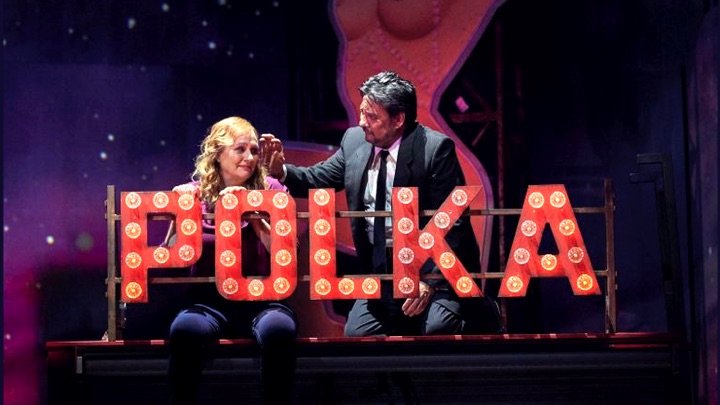
Their stars crossed, they fell in love; she won him in a poker game from the sheriff, shot him down off the gallows, and they rode off together into the endless California sunset. When the opera premiered, Frederick Jackson Turner’s “Frontier Thesis” was but 17 years old:
American democracy was born of no theorist’s dream. It was not carried in the Susan Constant to Virginia, nor in the Mayflower to Plymouth. It came out of the American forest, and it gained new strength each time it touched a new frontier. Not the constitution but free land and an abundance of natural resources open to a fit people, made the democratic type of society in America for three centuries while it occupied its empire.”
Turner, and the culture at large, worried that the frontier was closing, that Americans would grow soft and complacent without new worlds to conquer. In the East that Turner thought represented an authority and control fundamentally opposed to the West’s freedom, in the cities whose capital financed and profited off Western expansion, the cities where the brutal violence of Indigenous genocide and wars against Mexico and Spain were distant headlines and lines on a balance sheet rather than lived realities, people hungered for stories of how the West had been won.
While the event was an enormous media spectacle, critics balked at the music. It didn’t have hit tunes. The Times wrote that “few who heard ‘La Fanciulla del West’…think Mr. Puccini succeeded in injecting into it any ‘American local color’…such an impression and such an atmosphere are lacking.”
This is surprising to today’s listener, who’s heard the scores of the classic Westerns that borrowed from Puccini (and Wagner!) to create the sound of the myth of the West. To us, the surging introduction sounds like an MGM main title, the whole-tone scales like the first wide-angle shot of Monument Valley in a John Ford movie, the sharp, rhythmic clusters of tense chords like any scene where a cowboy rescues a damsel in distress.
This aftertaste of cliché, combined with California gold miners singing in Italian and the need to find a dramatic spinto who can convincingly handle a Remington, have made the piece hard to stage. But Puccini thought it was his best score, and so did Toscanini, who conducted the premiere and called it a “great symphonic poem.” When the piece premiered in Vienna in 1918, one fellow composer in attendance gushed: “A score with a thoroughly original sound. Splendid. Every measure a surprise. Very special sounds. No trace of kitsch!… I would so much like to study the score together with you.” His name was Anton Webern, and he was addressing his teacher, Arnold Schönberg.
There are of course reasons beyond theatrical believability that it’s hard to stage La Fanciulla del West. The piece was written as, and can easily become when performed, a kind of imperialist propaganda, a celebration of white supremacy, a love story staged on a pile of bones. The frontier was less a spiritual space of American democracy than a front of genocidal primitive accumulation, “one single catastrophe…piling wreckage upon wreckage,” the bloody theft of land and the instantiation of brutal forms of violence and domination.
Puccini and Belasco give us a white settler world featuring only two grunting and incoherent “Indians” who serve our white heroine, Minnie, with a kind of dumb gratitude, as though her Bible lessons were worth their freedom and land. But skepticism towards the expansionist project lurks just below the surface. “Cursed ground, this ‘Golden West’,’” sings one character near the piece’s beginning, after hearing that a friend has been diagnosed with yellow fever. “It’s the gold. It poisons the minds of everyone who hears about it.”
Our heroine, after all, does fall for a bandit and threaten to shoot the sheriff, neatly overturning standard patterns of law and order. “Social bandits,” wrote the historian Eric Hobsbawm, “are peasant outlaws whom the lord and state regard as criminals, but who remain within peasant society, and are considered by their people as heroes, as champions, avengers, fighters for justice, perhaps even leaders of liberation.”
Without going too far and arguing that Puccini and Belasco somehow meant to produce a critique of western expansion rather than a celebration of it, there is certainly enough ambivalence and sophistication in the score and the text that there is something there in the piece to be found about the myths of the United States, about violence, primitive accumulation, race, grace, and redemption. If the score (in addition to being a chromatic, sensitive, integrated whole) recalls American myths and its story retells them, there is an opportunity for a production to use the piece to investigate those myths and to deconstruct them.
If Lydia Steier’s new production at Berlin’s Staatsoper largely failed to do this, it was certainly not for lack of trying. A frenetic parade of images played out on the stage. Here was Fanciulla by way of The Rise and Fall of the City of Mahagonny, with the opening saloon just a dirty beer trailer parked in front of a neon-lit strip joint called the Paradise. Someone was hanged during the overture, and again at the same location at the end of the first act, in case you missed the point. Everyone carried a gun.
There was certainly always something new to look at: projected snowstorms, pickup trucks, even an enormous stuffed buffalo, named, the program informed us, Juanita. A traveling balladeer—whose first-act tune is one of the most hauntingly beautiful Puccini ever wrote—first flickered onto a television and then descended into view riding a pink neon heart surrounded by contortionists, as if in a Vegas stage show.
Pink-sequined cowboys occasionally danced across the stage. In a third-act fight scene, a super took a twenty-foot dive from a side wall of the set while others ran around brawling with their clothes on fire. For all the ongepatchket, though, the relationships at the center of the piece and the direction of the principals were mostly standard fare. We’re starting to get to the problem: while Steier’s staging declared its intention to dive deep into the work, its frenetic incoherence left it mostly splashing around on the surface.
In a director’s note, Steier, who is American, describes deeply religious rural white communities who live near her family in the American South. As a white woman, she says, she can pass, they say “god bless you” and act polite: but what, she asks, of racialized people, or queers? It is these kinds of communities, she says, that inspired her vision of the miner’s camp in the not-so-golden West. It is presumably to illustrate this intolerance that Nick, a waiter working for Minnie, is dressed up like Justin Vivian Bond; apparently the miners, who otherwise seem eager to kill anyone who’s at all different to them, just take this one in stride.
More troubling still was the treatment of Wowkle and Billy Jackrabbit, the two aforementioned “Indian” servants, who sing in a broken, stammering Italian. Here these figures were not visibly racialized but instead transformed into heroin addicts who, again quoting Steier’s director’s note, “can’t speak properly anymore because they’re so high.”
Wowkle and Billy’s child, who usually only briefly appears in the first scene of the second act, here framed the piece; the show opened with him sitting on the prompter’s box, watching popcorn, as if about to see a movie. He proceeded to haunt the action, waving baseball bats and toy guns; Steier proposed in her note that he was deciding whether to join the violence or to step away from it, that this new generation in this community could decide whether to replicate old patterns or break free.
But that’s the rub: the violence of the golden west was not a tragic curse, it was not some malevolent spirit that infected everyone equally. It was structural, and it was racial, and it was for profit. It is certainly convenient to try to wipe the piece of its deeply problematic depictions of Native people—and I am certainly not suggesting that the costume department should have raided the Karl May section of the local Halloween shop—but it is also a cop-out.
How could the child of Native people eking out an existence as servants on stolen land that was once theirs possibly be invested with the choice—or the task—of breaking cycles of violence? Does making Native characters into stammering, stumbling, incoherent addicts really help here? A new production of this piece declaring its intent to examine the dark side of the golden dream, set in such a specifically American West as this, cannot artistically or ethically refuse the task of addressing genocide. If you’re going to go there, you have to go there.
If the production did not do much to defuse the work’s minefield or emphasize its ambivalent relationship to the project of the West, it did provide a diverting frame for an affecting performance of the work executed at a very high musical level. In a way, the stars of the piece are the orchestra, chorus, and the singers who inhabit the minor roles; with 15 named parts, this symphonic poem is also an ensemble piece.
One would not have known from the full orchestra sound that a somewhat reduced orchestra was being used; Antonio Pappano conducted idiomatically and with great attention to the breath and needs of the singers and the shades of texture in the orchestration. If it was more poem than symphonic––there was maybe something lacking in the way that various beautiful parts assembled into a whole––there was also a great deal of loveliness to be heard, and just the sound of a great orchestra, there in the room, after so many months of closed theaters and livestreams, was incredibly moving.
The Staatsoper chorus was also excellent, as were many of the comprimario miners: special points go to the aforementioned drag queen waiter Nick, sung by Stephan Rügamer, a lively and game character tenor who often makes big impressions at this house in these kinds of key supporting roles.
Among the principles, the singing actress Anja Kampe was first among equals, singing a glowing, tender Minnie invested with deep attention to detail. She was at her strongest when she wasn’t pushing; sometimes, during some of the role’s unforgiving high fortissimo climaxes, a harshness crept into the tone. But at quieter or lower moments––slicing through the orchestra at Minnie’s entrance, singing about her childhood, or, in one of the loveliest moments of the first act, wistfully wondering “if I’d had more than thirty bucks of education, imagine what might have become of me”—the phrasing and tone were beautiful.

The bandit Ramerrez is invested, when he sneaks into the saloon to see Minnie and scope the place out for a robbery, with one of opera’s most unintentionally comic names: Dick Johnson. The tenor Marcelo Álvarez delivered a very honest and stylish musical performance; no strange tenor affectations, just clear and beautiful singing. He is not the most natural stage presence, which combined with the generic direction of the principals led to a lot of what Jeffrey Brown once called Kneels of Desperation, Thousand-Yard Stares, Expressive Palms, and Hands On Heart. (Mercifully, Brown’s Opera Sexy Dance was confined to the chorus, and to the first act.) But his slow and careful move from lighter to heavier tenor roles has left his voice audible but still light and flexible, with a smooth and even line. It was a privilege to hear him.
The baritone Michael Volle, making a role debut as Jack Rance, seemed to be having a terrific time smoking, shooting, drinking, and playing the bad boy (as opposed to the more dignified Wagner patriarchs he usually brings to this stage).
A filmed version of the premiere is available to stream until July 13.
Photos: Martin Sigmund
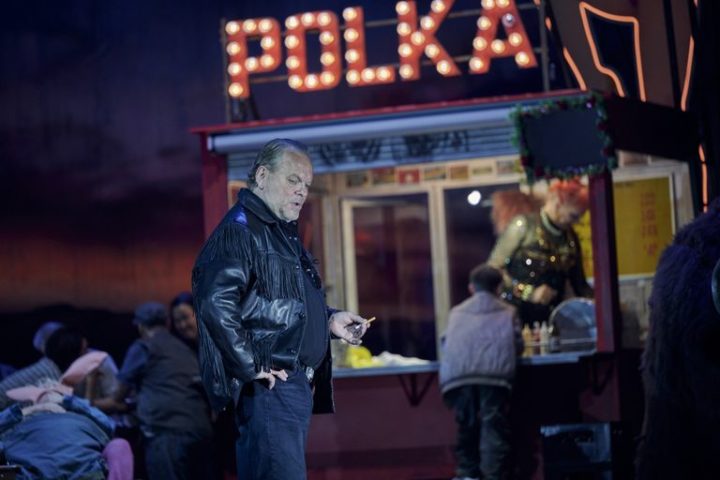

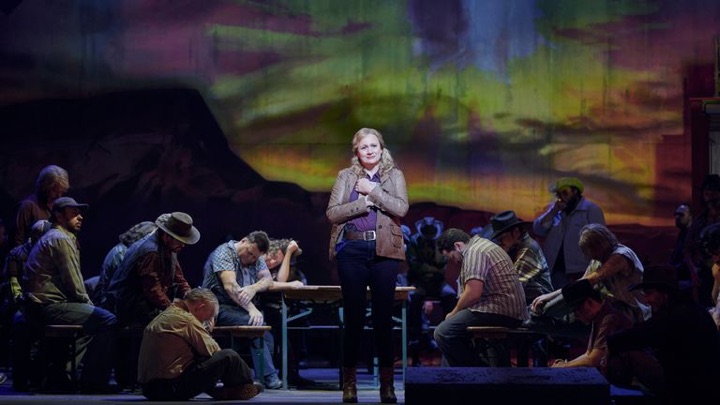
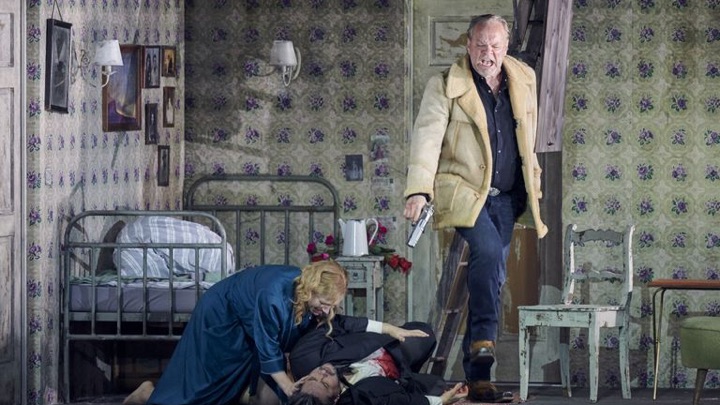
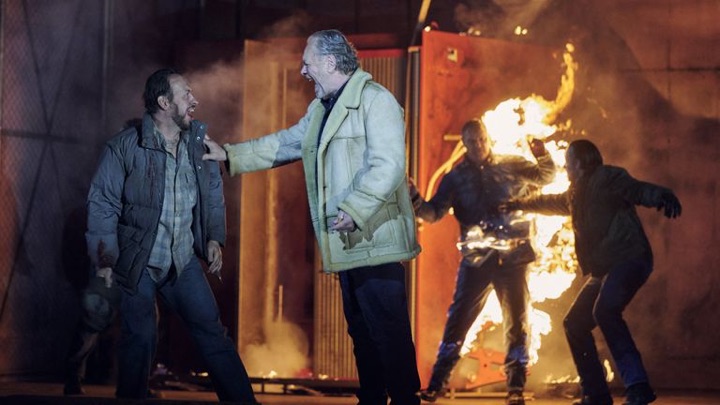

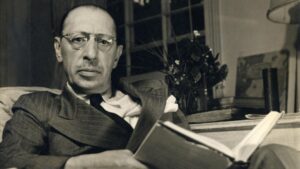
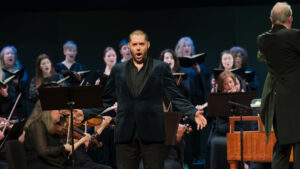

Comments